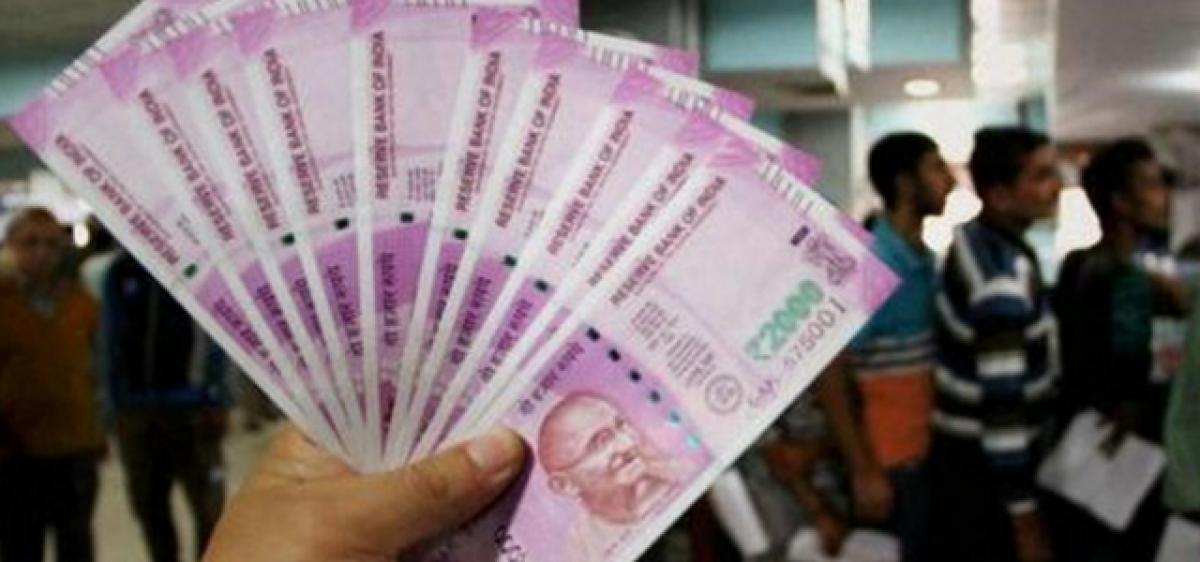Live
- BGT 2024-25: India will win Perth Test and series 4-1 to complete a hat-trick, opines Harbhajan
- Standing at work can actually be detrimental to BP: Study
- Election results: BlueKraft Digital Foundation CEO sees 'demographic shift and Ek hain toh..' as key takeaways
- Has Devendra Fadnavis replaced Sharad Pawar as new 'Chanakya of Maharashtra politics'?
- AAP celebrates Punjab wins, Kejriwal greets newly elected MLAs
- J&K Police recover Rs 4.48 lakh from financial frauds in Pulwama
- Neha Shetty ignites with golden look
- Nagarjuna makes interesting comments on ANR’s biopic
- Vijay Antony’s nephew Ajay Dhishan debuts as antagonist with ‘Gagana Maargan’
- ‘Thandel’ team releases striking b’day poster of Naga Chaitanya
Just In

Contrary to the claims of government, the fears over economic downturn due to demonetisation have proved to be a reality. According to the latest estimates released by the Central Statistics Office (CSO), in the last and fourth quarter of the last financial year, the GDP growth rate decelerated to 6.1 per cent. This is almost a percentage point lower than the provisional estimate in the last quar
Contrary to the claims of government, the fears over economic downturn due to demonetisation have proved to be a reality. According to the latest estimates released by the Central Statistics Office (CSO), in the last and fourth quarter of the last financial year, the GDP growth rate decelerated to 6.1 per cent. This is almost a percentage point lower than the provisional estimate in the last quarter.
The lower growth rate repudiates the claims of the supporters of demonetisation. The Gross Value Added (GVA) which is the much better indicator of the economic activity fell by 110 basis points over the previous quarter to 5.6 per cent. This indicates that the slowdown due to demonetisation was broad-based.
The note ban created an artificial monetary contraction leading to economic recession. The worst impact was felt in manufacturing, construction and financial services which recorded significantly lower levels of growth in the quarter that followed demonetisation.
It is wrong to claim that there was no adverse impact on the economy due to demonetisation, looking at the aggregate growth data which hides more than what it reveals. The disaggregated view provided by the sectoral growth data clearly establishes the debilitating impact of demonetisation.
The extent of slowdown in private sector is much more emphatic. The GVA growth data excluding the government sector show much sharper decline in economic activity across various sectors. The Finance Minister responding to growth data claimed that some slowdown was visible even prior to demonetisation.
It is true. But, the government cannot ignore equally truer fact that the economic slowdown was aggravated by the manner in which the demonetisation was carried out. It is easy for the government to blame it on global factors. Indian economy is certainly impacted by a host of factors.
But, one cannot miss the crucial fact that indiscriminate monetary contraction has strangulated the economic activity given the cash-rich character of economic transactions in India.
This is evident from the data which reveals that both gross fixed capital formation and private consumption as a percentage of GDP slowed down in the last and fourth quarter of last financial year as compared to the third quarter.
The aggregate numbers were only an optical illusion as the GDP includes defence and public administration etc., which really do not indicate any economic activity. The so-called buoyancy in GDP growth rate was primarily due to hike in defence spending and increased expenditure due to pay hike for government staff.
All these days, the leaders of government and their apologists have been rejecting the anecdotal accounts of shrinking economic activity especially in the months after demonetisation. But, now the official data itself acknowledges this.
Yet, drawing comfort from self-seeking explanations does not augur well for policy-making. At least now, the government should shed the inhibition and ideological rigidity and come out with a coherent action plan to kick-start economy and trigger growth in the productive sectors of the economy.

© 2024 Hyderabad Media House Limited/The Hans India. All rights reserved. Powered by hocalwire.com







